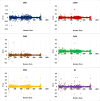Deep learning algorithm-enabled sediment characterization techniques to determination of water saturation for tight gas carbonate reservoirs in Bohai Bay Basin, China
- PMID: 38806579
- PMCID: PMC11133383
- DOI: 10.1038/s41598-024-63168-8
Deep learning algorithm-enabled sediment characterization techniques to determination of water saturation for tight gas carbonate reservoirs in Bohai Bay Basin, China
Abstract
Understanding water saturation levels in tight gas carbonate reservoirs is vital for optimizing hydrocarbon production and mitigating challenges such as reduced permeability due to water saturation (Sw) and pore throat blockages, given its critical role in managing capillary pressure in water drive mechanisms reservoirs. Traditional sediment characterization methods such as core analysis, are often costly, invasive, and lack comprehensive spatial information. In recent years, several classical machine learning models have been developed to address these shortcomings. Traditional machine learning methods utilized in reservoir characterization encounter various challenges, including the ability to capture intricate relationships, potential overfitting, and handling extensive, multi-dimensional datasets. Moreover, these methods often face difficulties in dealing with temporal dependencies and subtle patterns within geological formations, particularly evident in heterogeneous carbonate reservoirs. Consequently, despite technological advancements, enhancing the reliability, interpretability, and applicability of predictive models remains imperative for effectively characterizing tight gas carbonate reservoirs. This study employs a novel data-driven strategy to prediction of water saturation in tight gas reservoir powered by three recurrent neural network type deep/shallow learning algorithms-Gated Recurrent Unit (GRU), Recurrent Neural Networks (RNN), Long Short-Term Memory (LSTM), Support Vector Machine (SVM), K-nearest neighbor (KNN) and Decision tree (DT)-customized to accurately forecast sequential sedimentary structure data. These models, optimized using Adam's optimizer algorithm, demonstrated impressive performance in predicting water saturation levels using conventional petrophysical data. Particularly, the GRU model stood out, achieving remarkable accuracy (an R-squared value of 0.9973) with minimal errors (RMSE of 0.0198) compared to LSTM, RNN, SVM, KNN and, DT algorithms, thus showcasing its proficiency in processing extensive datasets and effectively identifying patterns. By achieving unprecedented accuracy levels, this study not only enhances the understanding of sediment properties and fluid saturation dynamics but also offers practical implications for reservoir management and hydrocarbon exploration in complex geological settings. These insights pave the way for more reliable and efficient decision-making processes, thereby advancing the forefront of reservoir engineering and petroleum geoscience.
Keywords: Deep learning; Machine learning; Petrophysics; Sediment characterization; Tight gas carbonate reservoirs; Water saturation.
© 2024. The Author(s).
Conflict of interest statement
The authors declare no competing interests.
Figures









References
-
- Wang G, et al. Characterization and origin of micropores in tight gas grainstones of the Lower Triassic Feixianguan Formation in the Jiannan gas field Sichuan Basin. Mar. Petrol. Geol. 2022;139:105609. doi: 10.1016/j.marpetgeo.2022.105609. - DOI
-
- Rashid F, et al. The effect of fracturing on permeability in carbonate reservoir rocks. Mar. Pet. Geol. 2023;152:106240. doi: 10.1016/j.marpetgeo.2023.106240. - DOI
-
- Zhu W, et al. The influence of movable water on the gas-phase threshold pressure gradient in tight gas reservoirs. Energies. 2022;15(14):5309. doi: 10.3390/en15145309. - DOI
-
- Fu J, et al. Productivity model with mechanisms of multiple seepage in tight gas reservoir. J. Petrol. Sci. Eng. 2022;209:109825. doi: 10.1016/j.petrol.2021.109825. - DOI
-
- Zhang D, et al. The role of phase trapping on permeability reduction in an ultra-deep tight sandstone gas reservoirs. J. Petrol. Sci. Eng. 2019;178:311–323. doi: 10.1016/j.petrol.2019.03.045. - DOI
Grants and funding
LinkOut - more resources
Full Text Sources

